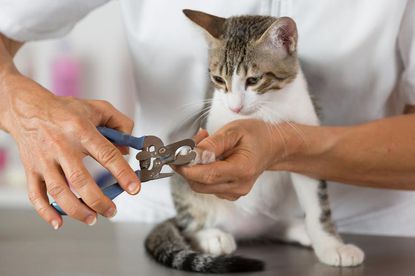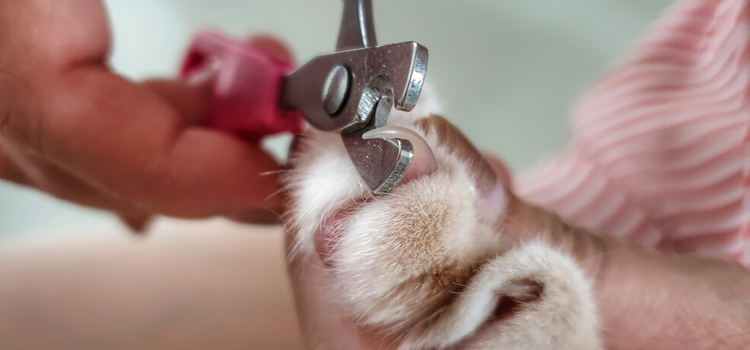Cats are fluffy, cuddly, affectionate, and super-cute until they start tearing the house apart with their sharp claws.
Sadly, scratching is instinctual to them. They do it to protect themselves, pass time, and flex their muscles.
There’s simply no separating our feline friends from this behavior.
You can trim your kitty’s nails, teach her to use the scratching post, praise her when she uses the post well or use nail caps.
These are great and work most of the time but not in all situations. If you are caught in this mess, it is natural for you to think about declawing.
Declawing sounds easy and harmless – almost like clipping your nail but it is more complex than that.
Experts say that the procedure is equivalent to removing your finger at the first knuckle.
It affects the cat negatively in so many ways.
Because of this reason, many opponents have come up to speak against the procedure.
So, do cats still declaw cats these days?
How Is Declawing Done?

Before we answer the question of whether vets still declaw cats or not, let’s examine the reasons the procedure is considered detrimental to our furry friends.
According to the Humane Society of the United States, declawing amputates the claws at the bone of each toe is located.
Vets use a guillotine clipper and a scalpel to amputate then cover the wound with surgical glue and stitches before bandaging them.
Another method is laser surgery where a small and intense beam of light is used to cut through the bone tissue by vaporizing or heating it.
Lastly, tendonectomy severes the claw controlling the claw.
The Negative Side of Declawing
The actual declawing process is straightforward. However, the damage it leaves behind affects the cat for life.
Endless studies have been published on this. All of them say one thing: declawing cats is inhuman, to say the least.
One example is this 2017 study published in the Science Daily Journal.
In the research, 137 declawed and 137 non-declawed cats were examined to determine any signs of pain, aggression, biting, and bad bathroom habits.
Out of the declawed cats, 33 were amputated on all four paws.
The researchers concluded that declawing triggers behaviors such as inappropriate biting (3 times more than non-declawed cats), over-grooming (3 times more), aggression (3 times more), and improper toileting (7 times more).
Earlier studies showed that declawing increased the risk of pain in the long term.
Additionally, the exercise lowers your cat’s defense and can put her in danger especially if she frequents the outdoors.
Things like reaching for food, catching prey, and walking can become cumbersome.
Do Vets Still Declaw Cats?

Source: cofundmypet
With all the risks of declawing in mind, it is hard to imagine that a vet can still carry out the procedure.
Surely, they know more about these risks than the average cat owner.
Well, the practice is very much in action. Some reports suggest that in America, 20-25% of pet cats have been declawed.
Clearly, declawing is still carried out in the United States and other countries.
Reputable vets agree that the procedure isn’t the best to carry out but they are forced to do it under specific circumstances.
For instance, the AVMA does not encourage declawing and claims that it is not medically necessary.
However, there are exceptions when the procedure is necessary. One of them is a situation where the scratching behavior of a client’s cat is causing injuries at home.
Also, if a cat owner tries other means to discourage scratching to no avail, the vet may carry out the surgical operation to save the kitty.
Vets from AVMA insist that the decision whether to declaw a cat or not rests on the cat owner.
They also ensure that the client knows everything about declawing before they give up their cat to be declawed.
Prof Danielle Gunn-Moore, the chair of feline medicine at the University of Edinburgh, who is also a vet spoke to BBC on the issue of cat declawing.
According to him, declawing has always been rare in the UK long before its ban in 2006.
“We weren’t taught about declawing at the university. It was later banned as more US citizens came to the UK accompanied by declawed cats.” He said.
Prof Gun-Moore went on to claim that he’s carried out declawing on two cats only in his life.
The reason he did it is because an elderly client gave him the ultimatum. It was either he declawed the cats or have them rehomed.
After contacting the Royal College of Veterinary Surgeons who gave the green light, he went ahead to declaw the cats.
Many vets argue that declawing is necessary if the cat is due to be put down without it.
Additionally, if the claws have tumors or any other deadly infections, the procedure is warranted.
Obviously, there are unscrupulous vets that still carry out the procedure without looking at other options first. They do this to get their daily bread without a care for the poor animals.
What Is The Outlook?
Declawing was once an accepted practice. It was essentially a service just like spaying and neutering.
It is now that the procedure has become controversial. Both the American Society for the Prevention of Cruelty to Animals (ASPCA) and the Humane Society strongly discourage clawing except when it is really necessary.
In the US, proposed legislations have come up to ban the procedure once and for all.
Individual cities including Denver, St. Louis, West Hollywood, Berkeley, Culver City, Santa Monica, Beverly Hills, Burbank, Culver City, San Francisco, and Los Angeles have banned it.
In 2019, the state of New York joined the list and outlawed declawing.
On a global scale, more than 42 countries have put a stop to declawing. These include England, Germany, France, Israel, Switzerland, and New Zealand.
Learn more here: States Where Declawing Is Illegal
Closing Thoughts
With all the controversy surrounding declawing cats, vets still carry out the procedure.
Those that have moral ethics do it to save the lives of pets. Their counterparts who have no love for animals amputate feline claws for profit.
In case you are considering going this route, consider other options first.
Contact a cat behaviorist expert to teach your cat how to use a scratching post, wear nail caps, and discourage scratching in the wrong places.

Hi! I am Eleanor Price. I started this website after my cat, Louie, almost died from a case of botulism (a type of food poisoning often caused by bacteria that grow on food items). Turned out that my cat’s diet was the problem. I have made it my duty to provide the best information and recommendations about everything cat lovers need to know about their felines’ health and wellbeing. My goal is to find the most informative content on anything feline-related and share it with fellow hardworking kitty lovers.

